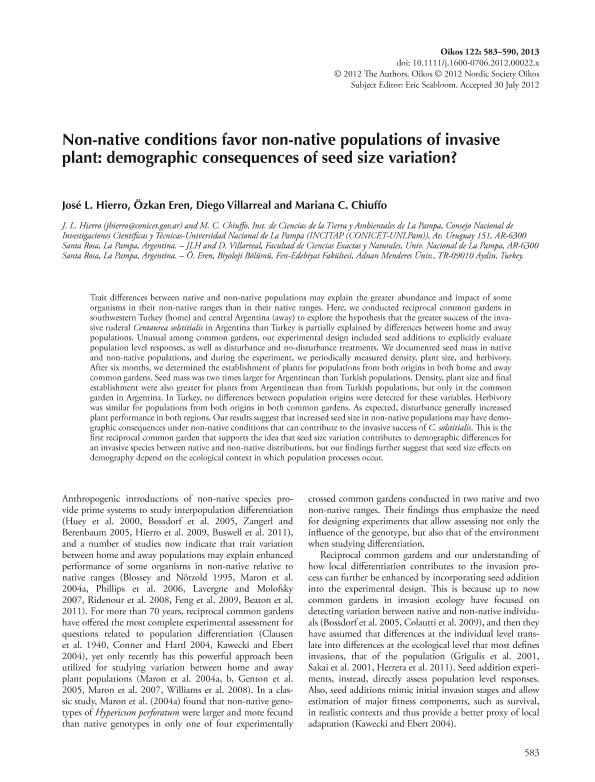Artículo
Non-native conditions favor non-native populations of invasive plant: demographic consequences of seed size variation?
Fecha de publicación:
04/2013
Editorial:
Wiley
Revista:
Oikos
ISSN:
0030-1299
e-ISSN:
1600-0706
Idioma:
Inglés
Tipo de recurso:
Artículo publicado
Clasificación temática:
Resumen
Trait differences between native and non-native populations may explain the greater abundance and impact of some organisms in their non-native ranges than in their native ranges. Here, we conducted reciprocal common gardens in southwestern Turkey (home) and central Argentina (away) to explore the hypothesis that the greater success of the invasive ruderal Centaurea solstitialis in Argentina than Turkey is partially explained by differences between home and away populations. Unusual among common gardens, our experimental design included seed additions to explicitly evaluate population level responses, as well as disturbance and no-disturbance treatments. We documented seed mass in native and non-native populations, and during the experiment, we periodically measured density, plant size, and herbivory. After six months, we determined the establishment of plants for populations from both origins in both home and away common gardens. Seed mass was two times larger for Argentinean than Turkish populations. Density, plant size and final establishment were also greater for plants from Argentinean than from Turkish populations, but only in the common garden in Argentina. In Turkey, no differences between population origins were detected for these variables. Herbivory was similar for populations from both origins in both common gardens. As expected, disturbance generally increased plant performance in both regions. Our results suggest that increased seed size in non-native populations may have demographic consequences under non-native conditions that can contribute to the invasive success of C. solstitialis. This is the first reciprocal common garden that supports the idea that seed size variation contributes to demographic differences for an invasive species between native and non-native distributions, but our findings further suggest that seed size effects on demography depend on the ecological context in which population processes occur.
Palabras clave:
Seed Size
,
Non Natives
,
Biogeographic Comparison
Archivos asociados
Licencia
Identificadores
Colecciones
Articulos(INCITAP)
Articulos de INST.D/CS D/L/TIERRA Y AMBIENTALES D/L/PAMPA
Articulos de INST.D/CS D/L/TIERRA Y AMBIENTALES D/L/PAMPA
Citación
Hierro, Jose Luis; Eren, Özkan; Villarreal, Diego; Chiuffo, Mariana Cecilia; Non-native conditions favor non-native populations of invasive plant: demographic consequences of seed size variation?; Wiley; Oikos; 122; 4; 4-2013; 583-590
Compartir
Altmétricas




